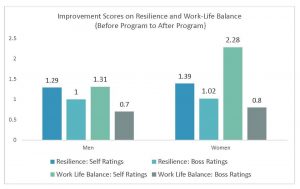I was sitting at a desk in the open-space of our La Jolla office, when a group of leaders who were on-site attending a five-day leadership development program gathered nearby for a closing activity. People were sharing their takeaways from the week, and commitments they would make to apply what they had learned. They shared examples of how they’d influence more effectively or delegate more consistently, among many other examples. I started to tune their voices out to focus on work when a man’s emotion-filled voice caught my attention. His commitment was to re-connect with his son who he hadn’t spoken to in years. He described how the program had made him realize that there is more to life than career success, and in order to be his most effective self, he needed to attend to and take care of other parts of his life. I felt my own emotions emerging as I listened in awe to his vulnerability and with pride for the work that our organization does.
Taking time to reflect, learn, and focus on development can have life-altering consequences for leaders. I’ve been doing research and program evaluation in the field of leadership development for more than a decade. One of the most rewarding parts of my job is reviewing data about how powerful the experience can be for individuals. The benefits to organizations can be impressive, too. But the stories and evidence about how individual lives are impacted — in ways that go well beyond the workplace — are what inspire me most. One specific area that we continue to gather more and more evidence about is how leadership development can have a positive impact on resilience and work-life balance; something so many of us need more of, perhaps especially this year!
CCL’s Leadership Development Program (LDP)® is designed to help leaders manage the challenges and pressures of leading from the middle, and help leaders develop their best selves to increase leadership effectiveness. So, what do we know about how effective this program is at helping leaders develop in two areas: resiliency and work-life balance?
First, we know immediately from end of program evaluations that leaders value this focus area in the program and comment on the new insights they had or the perspective it helped them achieve. When leaders are leaving the program on the last day, as part of the evaluation they complete, they are asked to rate each objective on how relevant it is for them as leaders and how well the objective is achieved. For the item, “Utilize tools, practices and techniques to more effectively build resilience,” leaders believe this is highly relevant to them and their needs (4.6 out of 5) and also indicate that the objective was met (4.5 out of 5). Examples of some of the comments from participants about their take-aways include, “I will work to create a more compassionate and healthy workplace,” and another, “I’ll be more aware about my own wellbeing.”
But what happens when these busy and often over-committed leaders return to work? Are they able to actually maintain a focus on resilience and work-life balance and do they continue to make improvements?
In many programs we send follow-up surveys and assessments as part of our standard practice. One follow-up assessment that we use (ReflectionsTM) is sent to leaders and their raters 3-4 months after LDP to measure behavior change and impact. In this particular assessment they provide ratings of where the leaders were before the program and also provide an “after” rating. Using a dataset of leaders who attended LDP and their ratersi, we learn a few things:
-
-
- Leaders, and every rater type in the dataset reported improvement in the leaders’ resilience and work-life balance, indicating that within a few months post-program, not only do leaders think they are doing better in these areas, so do the people they work closely with.
-
-
-
- Leaders themselves report more improvement in both competencies than all other rater types. In looking further at the “before” scores, self-ratings are on average lower than others’ ratings. This indicates that the leaders may perceive they had more room for improvement than others observed.
-
-
-
- Women leaders in particular report substantially more improvement in work-life balance than men, following the program. Again, their “before” scores are much lower, too, implying that women leaders may believe their work-balance was suffering even more than men prior to attending the program.
-

There are so many ways that a leadership development experience can be impactful for individuals, groups, organizations and even societies. Not every single leader will have a life-altering experience. Some may not improve, and others may make modest changes. Our impact data show that not only can leaders improve their perceived abilities to be resilient and balance work and life, but others see an improvement as well. We know that resilience practices are an important part of workplace culture, and we’re encouraged by this finding, and maybe leaders in our programs are even able to influence others in their organizations as well! And, like it did the father who committed to reconnecting with his estranged son, this kind of development experience has the potential to have a ripple effect that goes beyond any one leader or organization.
1 This is based on a dataset of 606 Women LDP Participants & 860 Men LDP Participants and 2,601 raters (Resilience) &: 230 Women LDP Participants & 406 Men LDP Participants and 1,111 raters (Work-Life Balance).


